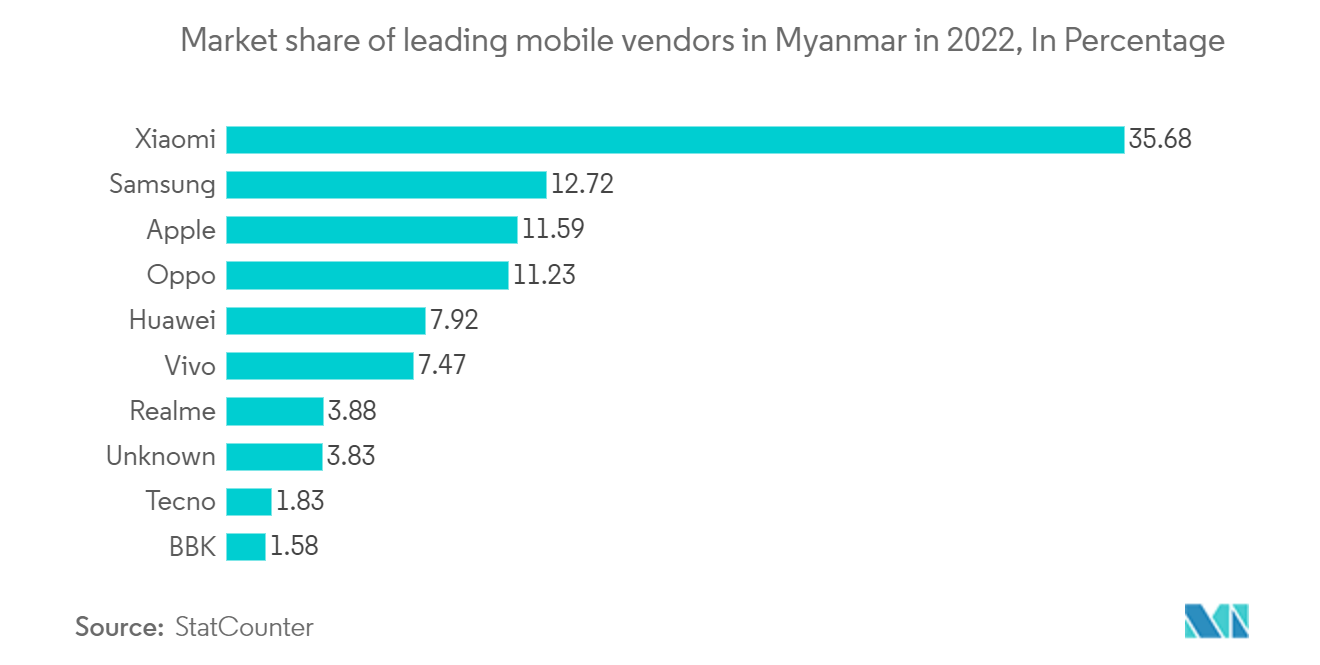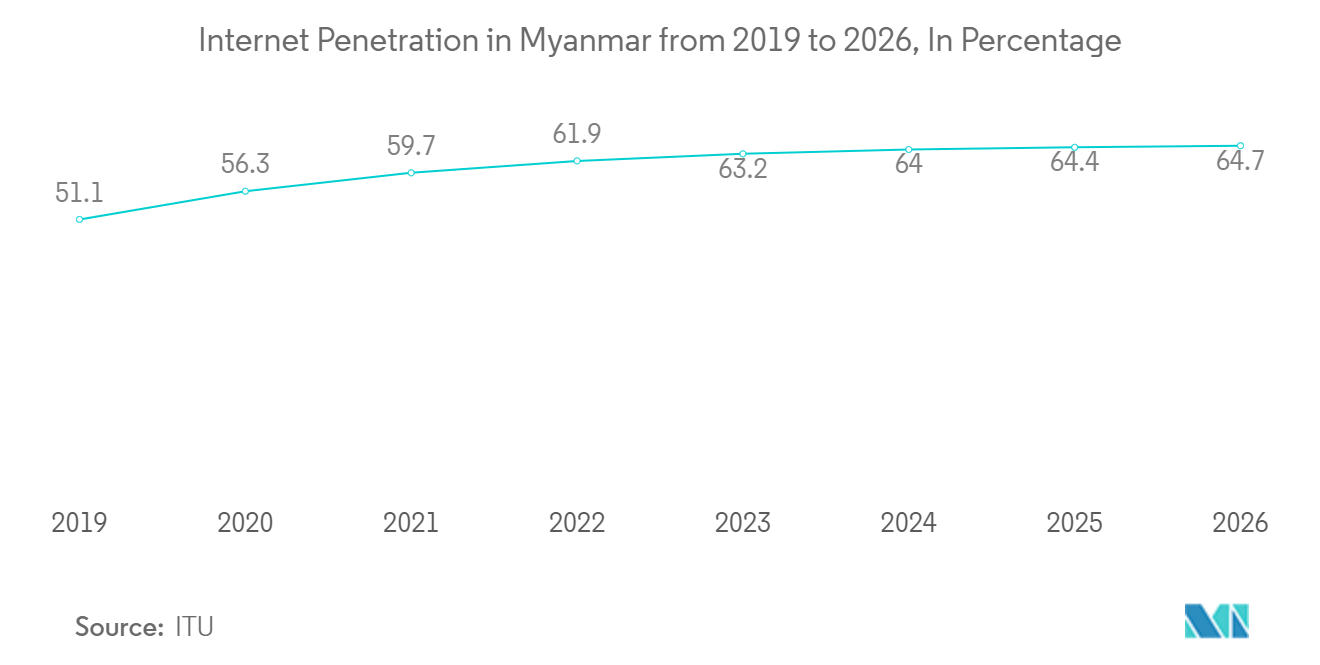Market Trends of Myanmar Telecom Industry
This section covers the major market trends shaping the Myanmar Telecom Market according to our research experts:
Growing Mobile Penetration in Myanmar
- Mobile technology is a crucial component of Myanmar's current initiative to increase financial inclusion and undermine unregulated remittance businesses. As a result of a revised national strategy and increasing competition, the telecommunication industry is performing better, which is transforming Myanmar's economy. Before 2014, Myanmar had one of the lowest global mobile penetration rates, at less than 20%. After the liberalization of the telecom industry, the situation considerably improved. Although the country lags behind its Asian competitors, it has been moving upward since the last decade.
- SIM cards and mobile phones were a luxury that only the rich could buy before Myanmar's telecommunications market was liberalized, but they are now becoming much more common. However, much work still needs to be done to increase network rollout. Due to massive investments and significant changes, most rural, formerly underserved villages now have access to mobile network coverage. As a result, Myanmar's heavily reliant cash culture is exposed to a wide range of fresh e-commerce goods and an emerging start-up ecosystem for technology.
- According to data from GSMA Intelligence, at the beginning of the current year, Myanmar had 73.48 million cellular mobile connections. GSMA Intelligence data depicts that Myanmar's mobile connections in the current year equaled 133.6 percent of the country's entire population. Also, between last year and the current year, Myanmar's mobile connection count climbed by 4.7 million (+6.8%). The people of Myanmar, particularly the rural population, are seeing significant improvements and wide-ranging advantages due to the ease of access to wireless services.
- Furthermore, rural residents now have more access to economic prospects within the nation thanks to digital technology, making it possible to stay in touch with friends and family across the country anytime. Additionally, the mobile app market in Myanmar is quickly emerging as one of Southeast Asia's most promising. Further, mobile gaming is sweeping the nation, with 80% of smartphone users and a population of well over 50 million. Myanmar is home to a sizable number of both domestic and foreign migrant laborers. Access to digital financial services via smartphones also makes it less necessary to carry significant quantities of cash, improving physical safety for many individuals.
- As per the chart below, Xiaomi is the leading mobile vendor in Myanmar, with a 35.68% market share in the current year. They are distantly followed by Samsung, Apple, Oppo, Huawei, and Vivo with 12.72%, 11.59%, 11.23%,7.92%, and 7.47%, respectively. On the other hand, Tecno and BBK hold the most negligible share in the market, around 1.83% and 1.58%, respectively.

Steady Broadband Growth
- Over the past few years, the mobile sector has grown quickly, which has fueled the rapid rise of mobile broadband. Due to Myanmar's relatively late telecom reform, fixed broadband connectivity has virtually been replaced by mobile device access to the internet. Although most of the advancements gained since a second military takeover undid the broadband network in the last year, broadband penetration continued.
- Over the next five years, mobile data sales in Myanmar are anticipated to increase due to rising mobile Internet subscribers and data average income per user (ARPU). Mobile broadband prevalence increased from low single digits to about 100% by the Covid-19 pandemic's onset in the five years following telecom market liberalization. The global health crisis was the first significant event to stop the market's ascent, but it was just a small blip compared to what Myanmar's second coup in February last year brought.
- In the last year, 4G was the leading tele technology across the country. Also, operators like ATOM and Mytel are increasing their 4G coverage with affordable handsets. The country's 5G launch is expected to occur in the coming year. To bring out the first 5G service in the market, ATOM declared its intention to invest hundreds of millions of dollars in Myanmar over the following years. Although there is no stated timeline for the project, the business is optimistic that it will launch within the next few years.
- Furthermore, while fixed broadband is slowly taking off, with subscribers mostly made up of FTTH connections, broadband fiber investments are developing, and growth is anticipated to flow through during the projected period, fixed lines subscriptions continue to be extremely tiny and stagnant. Encouragingly, increasing mobile broadband penetration over the next five years is expected to drive growth.
- Currently, MPT is the market-leading provider, followed by ATOM and Mytel. In the future, MPT is expected to be on the top of fixed voice and broadband markets. To encourage home consumers to sign up for fiber broadband services, the operator has been marketing fixed-mobile convergent plans with speeds of up to 100Mbps. The expansion of fiber broadband connections is expected to be boosted by investments made by operators like MPT and Mytel.
- According to ITU, internet penetration in Myanmar is expected to grow steadily from 2019 to 2026. As per the research, the country's internet penetration increased from 51.1% in 2019 to a stable 59.7% last year. Also, the expected internet penetration in Myanmar for the forecast period is 63.2%, and that of 2026 is 64.7% predicts the study.


